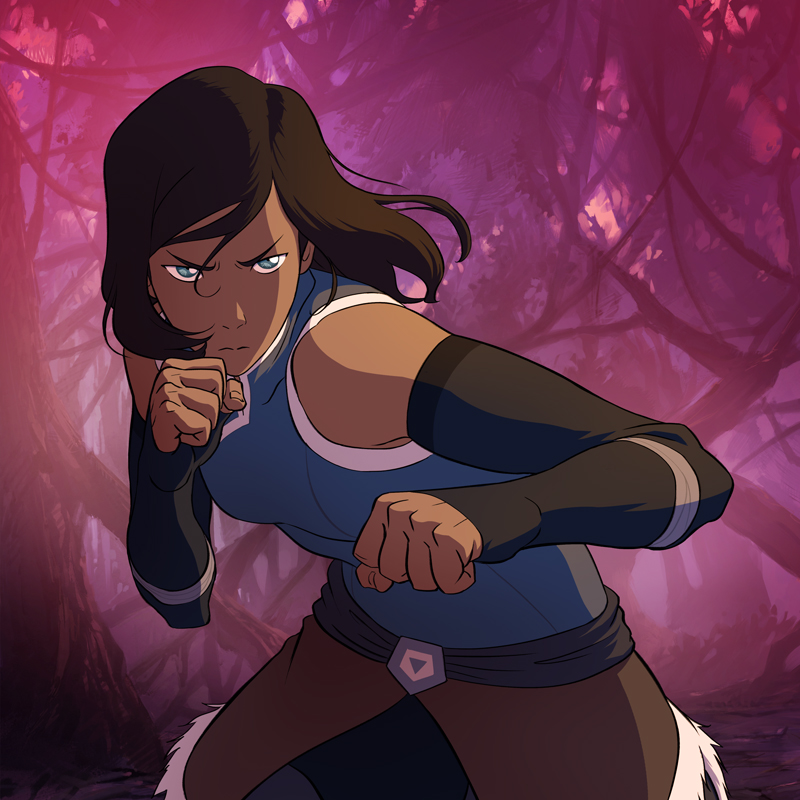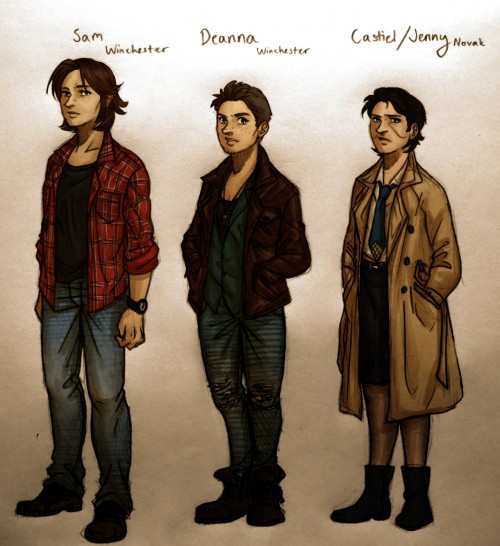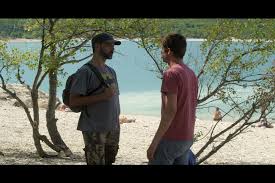
Written by Erin Tatum.
If there’s one thing I will never get tired of doing, it’s calling out lazy sexism in writing. Few shows have disappointed me more (at least initially) than The Legend of Korra (LOK), simply because of all the wasted potential. For a long time, I perceived LOK as a clumsy Y7 dilution of a horny teen melodrama that tainted the legacy of its golden predecessor, Avatar: The Last Airbender (A: TLA). There was far too much reliance on love triangles and romantic angst and on top of everything, the allegedly radical strong female protagonist was a hot mess. Korra (Janet Varney) was an impulsive hothead with an undying need to resist authority for the sake of it, caring more about the attention and approval of crush-turned-boyfriend Mako (David Faustino) than, well, just about anything else. She was whiny, entitled, and dabbled in internalized misogyny to boot, focusing most of her energy in the first season on undermining Asami (Seychelle Gabriel), Mako’s first girlfriend, in the rivalry for his heart. But it’s apparently justified at the time because Asami is girly and comes from money and therefore it’s automatically assumed she’s shallow or undeserving I guess?
Avatar Aang’s reincarnation may have been a lady, but she was a bit of a dick.

(The kids were also saddled with a miserable cast of piss-baby adults who redefined emotional dysfunction and clogged up screen time with their Maury-style family drama shitshow. I’ll have to stop here or you’re going to get six paragraphs about how much the adults ruin everything.)
Anyway, I digress. From weak characterization to network issues, LOK had a bumpy ride until the end. During the third season, Nickelodeon decided to pull the series off the air due to overly dark themes (although A:TLA tiptoed around such subjects, LOK never shied away from showcasing progressively less ambiguous scenes of death/suicide/murder). Rather than outright cancellation, executives took the unusual step of relegating the rest of the episodes exclusively to online streaming. The show thereby cemented its subversive reputation, with creators Michael Dante DiMartino and Bryan Konietzko seemingly taking advantage of the medium to push the envelope as much as they could.

The second season was an echo of the first in terms of rehashing pointless romantic fodder, but things finally hit their stride in the third season, ironically right when it was pulled from television viewership. Thankfully, following a tumultuous relationship and a messy breakup in Book 2, Korra and Mako stayed apart with shockingly little ship tease the rest of the series. I’m still in disbelief about that one. I can’t believe the breakup actually stuck and that the writers were able to resist the temptation to constantly throw them back into will-they-won’t-they territory. That’s a good message though–not all relationships work out, and you don’t have to feel pressure to stay with someone forever just because you have history. People can learn things from each other and move on. More significantly, the breakup paves the way for Korra to develop a friendship with Asami, who fast becomes Korra’s primary ally and confidant the rest of the series. They’re able to work past their former rivalry to build a relationship independent of shared history with Mako. The connection is heartfelt and genuine and doesn’t just feel like a belated attempt to hastily past the Bechdel test like I originally feared.
There’s also a few phenomenal standalone episodes that shed light on general Avatar history. They brought tears to my eyes not only because they were so good, but because they reminded me that DiMartino and Konietzko do still have the ability to tell beautiful stories when they aren’t mired down in cheesy interpersonal dynamics.

The fourth and final season (Balance) finds Korra struggling to recover from her latest near death experience, suffering from implied PTSD as repeated, terrifying flashbacks prevent her from fully regaining use of her Avatar powers. Three years have passed since the previous season, putting Korra and her friends into their early 20s. This was one of the best creative decisions of the series in my opinion. It feels a little weird to arbitrarily set the final chapter three years in the future when the first three books have taken place in a relatively slow-moving linear timeline, but the last-minute time skip enables the kids to do something that shoddy writing has always held them back from: growing up. Team Avatar are all young adults now. They don’t have time to worry about who they’re dating because they’re all trying to hold down jobs and working for different corporations and navigating different politics and world views. Even the airbending kids (Aang’s grandchildren) take on much more significant roles as we return to find them entering their early teen years. The show finally takes a break from stirring the bubbling cauldron of pheromones to at last rediscover what should have been at the heart of any A:TLA franchise–teamwork and friendship.

With her confidence and fragile psychological state badly shaken, Korra has been in isolation since her last enemy tried to poison her to death, choosing to remain in contact with only Asami (suck it Mako). This new older version of Korra is the polar opposite of the headstrong teenager we first met. She’s quiet with a sobering jaded outlook on life, with everything down to her weary body language indicating that her spirit remains just as broken as the physical injuries that brought her to such a darkened mental place. Alas, there is once again trouble brewing on the horizon and Korra must return to face her responsibilities in spite of all of her fears of inadequacy. Harsh dictator Kuvira (Zelda Williams) is conquering villages left and right, becoming increasingly drunk with power under the guise of creating an idealized utopia, a mission for domination that threatens to throw the world out of balance. See what I did there? I have to admit that I’ve never been a fan of the whole “new radical extremist appears to hand Korra’s ass to her every few months” formula of each season because I feel like it disconnects the books from one another as opposed to the steady buildup to the ultimate conflict in A:TLA, but I will say that the execution of this season plot wise is the most compelling. The threat of Kuvira is definitely more intense than the other villains, so the stakes are appropriately higher.

I’d also like to take a minute to discuss the importance of Jinora, Aang’s oldest granddaughter, because I don’t feel like she ever gets enough credit for being awesome. (Also, she’s voiced by Kiernan Shipka, aka sass queen Sally Draper, which blew my mind because I’ve watched her on Mad Men since she was like 6 and holy hell I’m getting old.) Jinora has been the feminist heartbeat of LOK long before Korra ever got her shit together. Whereas Korra had to be physically annihilated 932 times to actually learn any kind of lesson, Jinora always possessed calm, precocious wisdom and a deep sense of spirituality. She could connect to the spirit world without breaking a sweat. She’s probably around 14 or 15 in the last season. Getting to see her mature and grow into her talents was a real treat. Throughout Book 4, she protects the city, communicates with spirits, and teleports via spirit like a boss. Korra is very protective of her and they have a big sister/little sister type of bond, but Korra should also take notes. Forget Korra’s mopey ass, Jinora is everything that I want to be when I grow up. I don’t care that she’s eight or nine years younger than me. As a bonus, she also has one of the only healthy (not to mention adorable) romantic relationships on the show, even if that could be written off as a function of youth.

Korra’s gravitation away from brute strength fighting and toward peaceful negotiation tactics was a massive testament to her personal growth in itself, but the most significant crescendo of her character arc came in the form of the final scene of the series. I’ll try not to spoil most of the finale. A lot of people pass out midair and other people catch them. I think you can guess who won the battle of good versus evil. Once everything winds down, Korra has her final meaningful conversations with those closest to her. I bit my lip nervously as expressed her gratitude towards Mako for assisting her in the fight. After a reunion so late in the game, I fully expected everything to wrap up with a humdrum obligatory affirmation of heterosexuality. No matter how I feel about Korra and Mako together, we did have to suffer through two entire seasons of being beaten over the head with the idea that they were the ultimate fated alpha couple. It’s a kids show, so closure is expected and almost mandatory. But the writers miraculously stuck to their guns. A simple “I’ll always have your back” and meaningful glance and that was that. Not even a kiss! Keep that in mind, because we’re about to get analytical.

Suddenly–could it be?–the heavens opened up and the powers that be smiled upon us all. Korra spends her last moments of screen time with…Asami? Is this real, or am I dreaming about fanfiction? Asami tells Korra she couldn’t bear to lose her and Korra suggests they take a vacation together. Asami says she’d love to visit the spirit world. She and Korra then walk alone, hand-in-hand, into the spirit portal. The final shot of the series is the two of them clasping hands and gazing into each other’s eyes while being enveloped in the golden light of the portal.

To me, that’s about as queer of an ending as a kids show can get.
A few articles and legions of rejoicing Tumblr fans have chosen to interpret the ending as implying that Korra and Asami are together romantically. It makes sense. The two of them have been building a relationship for years. I also think it’s significant that the scene with Asami occurred after the scene with Mako. Korra had the opportunity to go off into the sunset with Mako, but she chose Asami instead. Asami is the most important person in Korra’s life. It’s no coincidence that that scene almost directly mirrored A:TLA‘s final shot of Aang and Katara kissing in the sunset. Minus the kissing. Sigh, minus the kissing. How awesome is it that two girls who started out resenting each other over a boy end up choosing each other over everyone else? Talk about every queer shipper’s wet dream.
Predictably, this interpretation has drawn an irritated outcry from fans who insist that the subtext simply isn’t there and Korrasami shippers are delusional. I can’t tell you how many times I’ve read something along the lines of “but no, they’re like sisters!” in response to even the most vague allusion to romantic ties between Korra and Asami following the finale. Women are already oversexualized or desexualized constantly in media. The second that anyone dare suggest romantic overtones in girl/girl friendships, in comes the sister argument. Sisters are wholesome and loving within appropriate boundaries! Oh my sweet summer children, have you ever read Frozen fanfiction? Many, many people want Anna/Elsa to get it on, and they’re actual sisters.
The Korra/Mako scene was equally open-ended, but no one’s going to complain about fans who want to interpret that moment as suggesting a romantic future between the two. No one’s going to say “but they’re like brother and sister now!” Granted, they already dated. You get my point. Compulsory assumed universal heterosexuality is the bane of my fandom existence.
I wanted to put something else witty here, but I can’t because this actually makes me really fucking angry and it’s important to talk about why. Most people love to talk about how they support gay people (and I say gay because the straight community has far less understanding and patience for bi/pansexuality), but as soon as the possibility of queerness encroaches into the children’s genre, it becomes dirty and perverse. You do realize that gay people were all once gay kids, right? Kids need to see that kind of representation, regardless of their orientation. For one thing, it’s important to show that a girl can love a girl, but another message of equal importance is that just because love looks different doesn’t make it less than any other kind of love. As a disabled kid, I never exactly saw anyone swooning over people in wheelchairs, but every time I saw anything that broke with your run of the mill romance, it gave me a spark of hope. The emphasis shouldn’t be on moaning about ruining childhoods or turning kids gay, but rather on illustrating that everyone deserves fulfilling relationships with people who love you, whomever they may be.
Ultimately, Korra evolved from an insecure teenager eager to define herself around a boy to a confident heroine who found strength in another woman who believed in her. She may have made me want to tear my hair out in the beginning, but with Asami’s help and the help of her entire support system, she proved herself deserving of the Avatar title as well as finally living up to all the strong female protagonist hype. Once rivals, Korra and Asami became lifelong allies who may or may not kiss occasionally in the future.
In Asami, Korra finally found her balance.
UPDATE: Bryan Konietzko has confirmed via his Tumblr that Korra and Asami ended the series as a couple.












